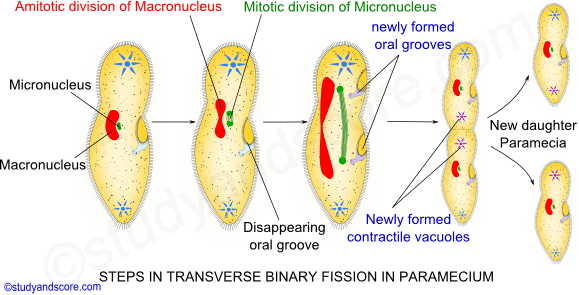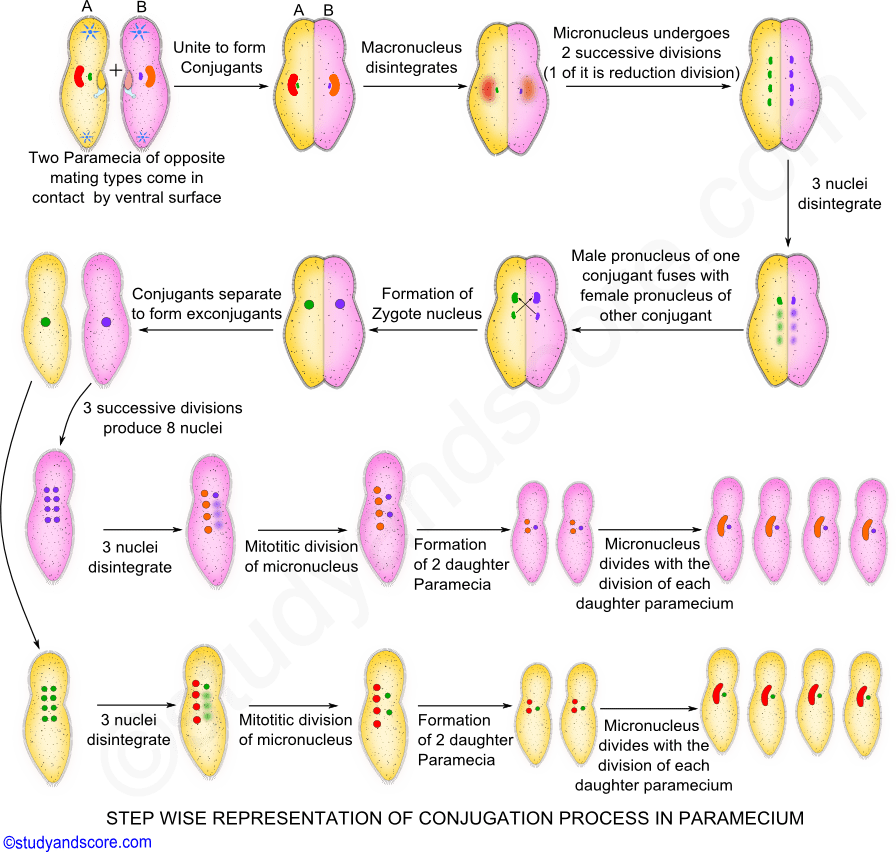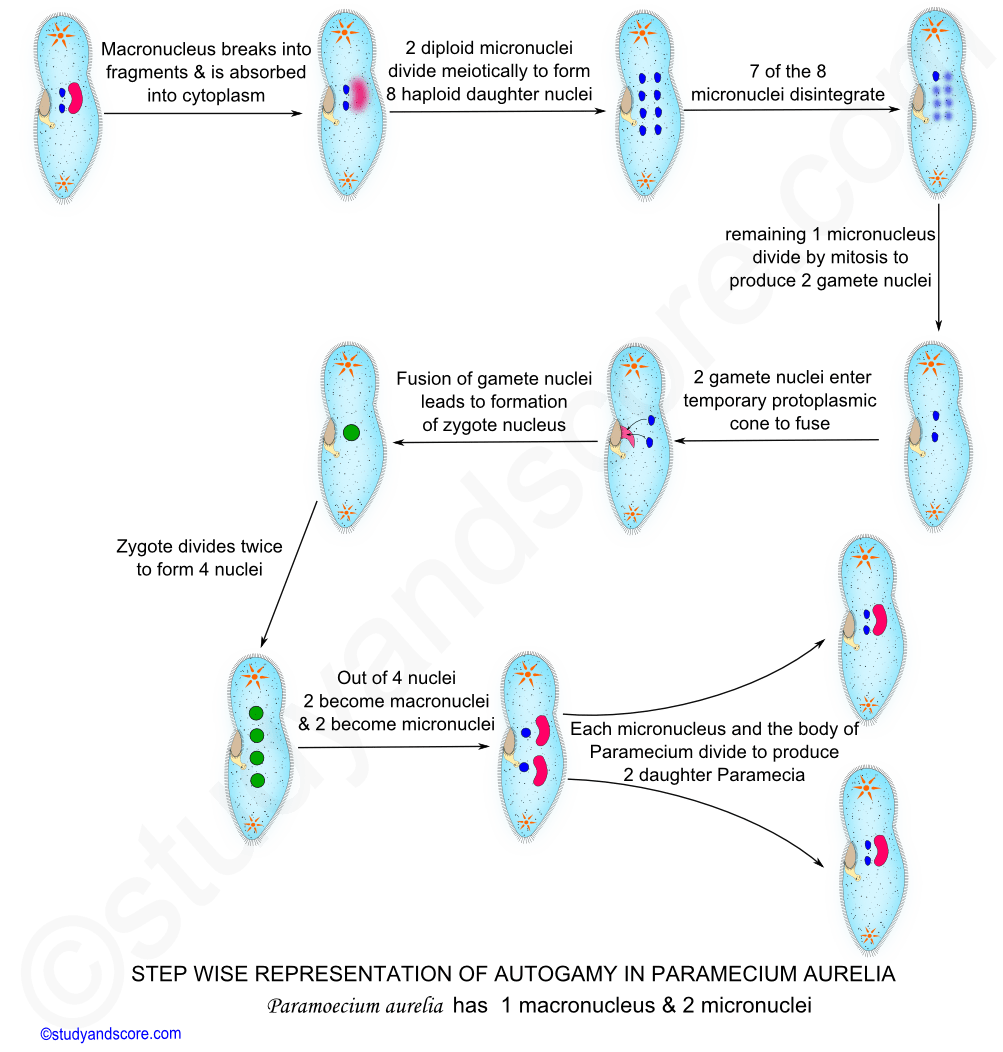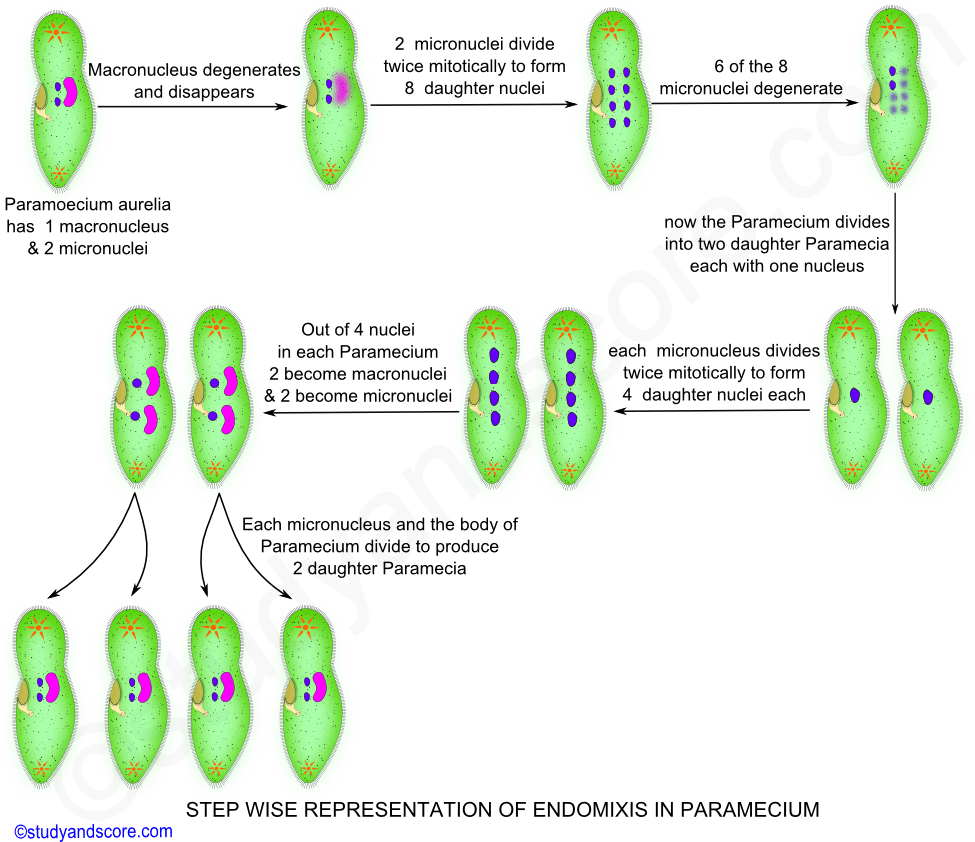Paramecium reproduces both asexually and sexually. It also undergoes several kinds of nuclear organizations. It can also multiply during nuclear organizations. Various processes of reproduction in Paramecium are listed below:

The degeneration of old macronucleus and the formation of the new one by fusion of micronuclei is called as nuclear organization. In binary fission the macronucleus divides by amitosis in which chromosomes are distributed at random to the daughter macronuclei. Due to repeated binary fission, genic balance of macronucleus is disturbed. This imbalance reduces the vigors and vitality of the clone. Rate of binary fission also reduces. For example, it has been shown that some species of paramecium can pass through only about 320-350 continuous asexual binary fissions. If the nuclear organization fails to occur, the asexual clone dies.
Replacement of the imbalanced macronucleus thus is very important. The new macronucleus has rejuvenating effect on the clone. A new macronucleus is produced by the following processes:
1. Conjugation
2. Autogamy
3. Endomixis
4. Cytogamy
Whereas, binary fission is an asexual reproduction process in which nuclear organization does not occur.
Binary fission occurs in transverse fashion in Paramecium. It is a common method of reproduction in Paramecium which occurs during favorable condition. A fully grown Paramecium is divided into two daughter individuals. Division occurs at the right angle to the longitudinal axis of the body. Nuclear division is followed by the cytoplasmic division.

Paramecium stops feeding before initiating binary fission and then its oral groove disappears. Macronucleus divides by amitosis and micronucleus divides by mitosis. After division, they move towards the opposite end. At the same time, the constriction develops at the middle part of the body which divides cytoplasm into two equal parts. In this way, two daughter-Paramecia are produced.
Daughter from anterior end is called protor and another daughter from posterior end is called opisthe. They are of equal size and contain a complete set of cell organelles as in parents. Oral groove and cytopharynx are newly formed in both the daughters. One contractile vacuole goes to protor and another to opisthe. Other two are newly formed. The whole process is completed within 2 hours and may occur one to four times a day.
In Paramecium, Conjugation is a form of sexual reproduction. It is a temporary union of two individuals of same species for mutual exchange of genetic materials. Continuous multiplication by binary fission is interrupted by conjugation as it is necessary for the survival and rejuvenation of the race.
Conjugation inducing factors: The following are the factors which induce conjugation,
Types of mating systems in paramecium: Each variety of the species of paramecium has two mating types which differ in chemical characteristics of their surface membranes. Conjugation can occur only between different mating types of the same variety or syngen.
Conjugation process: The two Paramecium of opposite mating types come in contact by their ventral surface during swimming. They stick together through their oral groove region. Following this attachment their cilia, Trichocysts, feeding apparatus degenerate. Pellicle and ectoplasm degenerate at the point of contact and a cytoplasmic bridge. This cytoplasmic bridge is also known as protoplasmic bridge or Conjugation Bridge. These united paramecia are called conjugants.

The conjugants attach with each other for several hours during which complicated reorganization and exchange of nuclear material occurs as described below,
Changes in macronucleus: The macronucleus breaks up into fragments and these fragments are later absorbed into the cytoplasm.
Changes in micronucleus: Lot of complicated changes and divisions take place in the micronucleus.
In this way, 8 paramecia are produced as a result of conjugation four from each mating conjugant.
Nuclear Reorganization: In conjugation new and metabolically active macronucleus is produced by reorganization of micro nuclear materials.
Rejuvenation: In conjugation old, weak and defective macronucleus is replaced by new one which can control metabolism growth and the environment. Because of this paramecium is rejuvenated i.e. it gains the previous vigor.
Genetic variation: In conjugation, genetic materials are exchanged between Paramecium of opposite mating types. It brings variation in daughter individuals due to genetic recombination.
W. F Diller in 1936 described Autogamy in Paramecium aurelia. The nuclear changes occurring in both conjugation and autogamy are much similar but nucleus is not exchanged in autogamy. Moreover autogamy occurs within a single individual. Autogamy occurs in the following way,

Significance of autogamy
Woodruff Erdmann reported endomixis in Paramecium aurelia. It is one of the methods of nuclear organization. There is no meiosis and no nuclear fusion in this process.
It occurs in single individual in the following way,

Significance of endomixis
R. Wichterman in 1940 reported Cytogamy in Paramecium caudatum. Generally cytogamy is less frequent. In cytogamy two Paramecia form a pair and become attached at their oral surface as in conjugation. Early nuclear divisions are similar to that of conjugation but there is no nuclear exchange between the individuals called as cytogamonts. Two haploid gamete nuclei in each of the individual, fuse to form a synkaryon. The individuals now separate and divide as in conjugation. Also a new macronucleus is formed as in conjugation.
Significance of cytogamy

- Share with your friends! -
Login to post your comment here...
- or with social Account -